March 13, 2015
The Story Behind the Image: Moai, Sitting for Portrait
Let met start at the beginning: It was 1967 and I had borrowed the book Aku Aku from my high school teacher, friend and mentor, John Holland. This is how I was introduced to the Moai of Easter Island.

I became fascinated with the Moai and would spend hours and hours trying to imagine how and why they were built and even more perplexing: why they stopped? Even though this was my only “contact” with the them, they have been on my mind these many, many, many (you get the idea) years.
And interestingly, I have always imagined the Moai as being living beings.
Fast forward to 2014: I am planning my next photography trip and discussing with my wife where I might go. Easter Island had always been on my bucket list but I never really believed that I’d be able visit due to it’s remote location. But over the next several days I began to question that assumption and a few weeks later the trip was planned.
In keeping with my Photographic Celibacy I did not look at what other photographers had done before me. I wanted my Vision to be pure and unsullied by the ideas and Vision of others. However this approach has some disadvantages: what if I created work that was similar to what others had done, simply because I didn’t know what others had done?
I was willing to take that risk and proceeded blindly.
My trips are never planned, I simply go to a location, wander about and trust that something will inspire me. However this can cause great anxiety if I don’t find something that sparks an idea quickly and I start to worry that I’ll come home empty handed. I’ve had that happen to me several times before but fortunately something always seems to capture imagination and passion.
As we flew to Easter Island I like a child on Christmas eve, wondering what gifts I would find in the morning. And as I wondered what the morning would bring I fell asleep and dreamt, I dreamt that I had met the Moai and invited them to come to my studio to sit for a formal portrait…and they did!
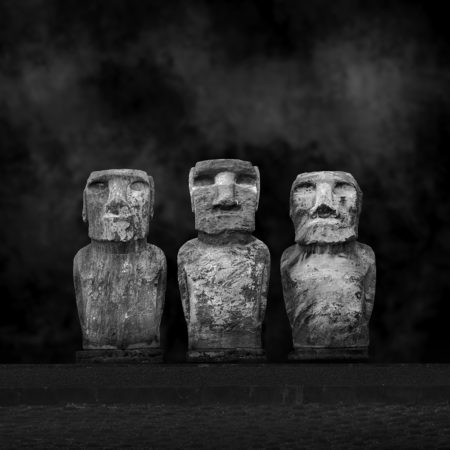
When I awoke I thought to myself, why not? I had always thought of them as being alive and I would create studio portraits of them as though they were. This idea really got me excited, as excited as I’d ever been for a project. It just seemed like a natural for me!
I was certainly out of my depth in several areas: I have no portrait experience, I could not control the lighting and I had never done anything this complex in Photoshop before. But a lack of skills has never stopped me before and instead I viewed it as a challenge.
In my mind I laid out my plan of action: I would photograph the Moai as though they were sitting in my studio, a tight shot and at appropriate angles. I’d try to catch them in diffused light and later I’d try to make it look like studio lighting. And lastly I’d outline the Moai and drop them into a digital backdrop that I would create.

I had to get the shots right because I had only one chance at this. I took a huge number of photographs from every angle and vantage point I could think of. I followed the sun and each morning went to one side of the island and each afternoon I went to other. Because I was looking for subdued light and could not control what I got, I had to wait for many hours at each location for a cloud to pass overhead.
Once home I started off by creating a portrait background for my Moai. I then blurred it to give the image a shallow depth of field and a three dimensional look. Later when I looked at all of the images as a group, the background looked redundant and so I created several slightly different versions to break things up a bit.

Next I needed to learn how to outline the Moai. I was very fortunate to be working with objects that had hard edges which made the outlining much easier. A great deal of this work had to be done manually at 300% magnification because the Moai’s background interfered with some of the more automatic methods of selection. This is where a tablet really shines, I simply could not have done this outlining with a mouse!
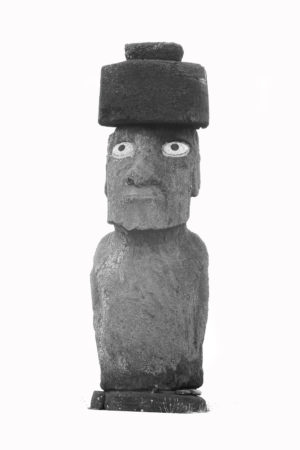
Next I pasted the outlined Moai into the background but felt that it looked unnatural. I learned that an object looks “pasted in” when the edges of the object are sharper than the object itself. So I took a 3 pixel blur tool and manually blurred the edge of the Moai at 300% magnification.
Then came the lighting: how could I make the lighting look as though the Moai had been lit in a studio? With no lighting experience, I simply experimented with dodging and burning, trying to make the light source appear to come from a particular direction.
With a small amount of practice I found I could bring a Moai to this point in about an hour. But the final refining of the image is what took the longest.
I would let the images sit for a week and then would come back to see them with a fresh eye. On the first pass I was unhappy with the lighting and modified it quite a bit; lessening the directional lighting effect and opening up the shadows more. I let it sit for another week and tweaked some more. And then I repeated this a third and fourth time until there were no more changes.
Here are a couple “before and after” images to show you the original shot and the final image.
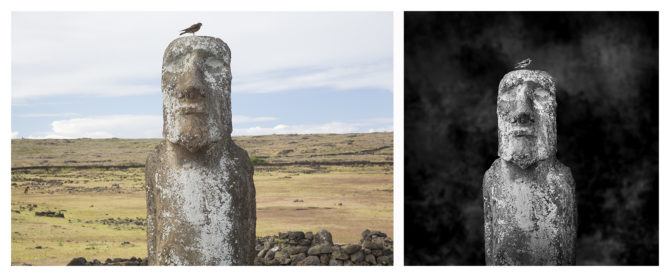
Outlining was easy when the Moai were against the sky and I could use the automatic methods of selection. But when the background was cluttered as in the lower half of this one, I had to manually outline.
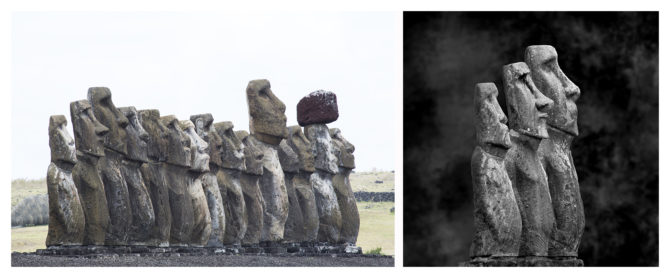
When I shot this image I was not thinking portraits, but these first three Moai on the left worked out perfectly anyway.
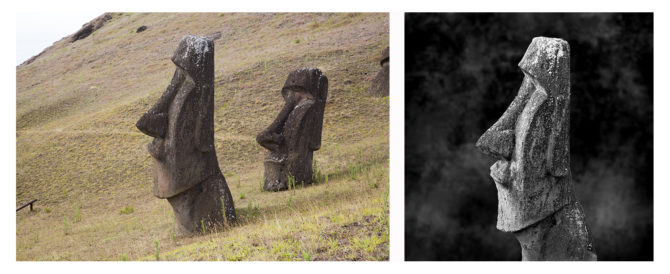
The images from the quarry were harder to put into the studio because they were photographed against the grass. I had to stay on designated paths and that limited my choice of angles and consequently the background. These images were completely hand outlined and often I had to clone out the weeds that were in the way.
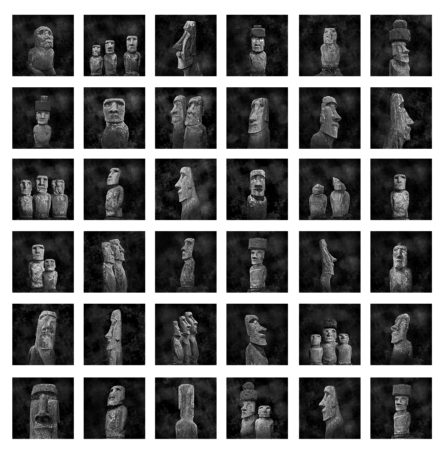
In the end I created forty portraits of the Moai and I love them. The trip was a wonderful adventure in itself, but to pursue a project that treated the Moai as though they were alive, really was dream come true.
This project reinforced three of my guiding principles as a fine art photographer:
1. I must pursue a project that I am passionate about and have a Vision of.
2. Skills come second to Vision. If I don’t have the skills, I can always learn the them.
3. I must create for myself and love what I’ve created.
Cole
P.S. You can see the full portfolio here: http://www.colethompsonphotography.com/MoaiSittingForPortrait.htm


Thanks ever so much for the technical details. I’ve been fascinated with all the shots but now that I see them as a set and understand how you managed to create the portraits, I’m even more intrigued. Beautiful work. Thanks for sharing.
Utterly brilliant and superbly excuted! xo
A wonderfully, clever series Cole. The back story was refreshing and honest as always from you. Great work!
When I saw the initial images you posted days ago I wondered: “This doesn’t look like anything Cole has done before.” For me this is a case of wonderful images being enhanced by the story. No analogy is perfect but this reminds of when beautiful music and the poetic lyrics, wonderful onto themselves, provide something even better when merged. Thank you for sharing your story and, in particular, the before and after images. Dreams due come true sometimes.
Thanks for the back store. Great images!
Thanks for the explanations – was wondering how you did them. Lovely, personal collection of portraits.
What an enjoyable story, and the behind-the-scenes shots and information are stellar!
Beautifully done.
Thanks for sharing your process, Cole.
I loved the final results, congrats!
One technique I’ve found can help with creating “lighting” effects is using Control Points in Silver Efex 2… have you tried it?
I love it when a plan comes together! Congratulations, Cole.
Outstanding series, especially considering how they’ve been photographed thousands of times before.
And I absolutely love your 3 guiding principles.
Great work, Cole.
A fascinating insight into your creative processes – and such wonderful results. The subjects of your portraits really do seem to live and breathe
Love your interpretation on these Cole. Fantastic project.
It’s so special when a creative person lets us into their mind.
Standing O, Cole. For both creative vision, execution, and post processing, and proving once again how those Siamese triplets are all linked at the hip.
I see a book here, or at the very least a solo gallery show, probably internationally. Your giving the Moai a human dimension further sets this series apart, and could well make this series as unique and lasting as Auschwitz is to the Holocaust.
Ironically, in Auschwitz you converted human forms into ghosts. Here, you gave ghosts of a mysterious past human dimensions.
Once again, standing O. Bravo!
Sam
Wonderfilled series Cole, hope to see the prints!
Great work. I often do manual selections at 1000%. A mouse works just fine for this. This morning I did a scenic of manually selecting a grove of trees that took me 5-1/2 hours. I set my processor so it doesn’t go to sleep so I can take breaks.
As always Cole , fine artistic work. The composition of each image is fine composed and gives me good mood. This is good !! I really supports your guidlines – it is important to follow their own ideas.
Magnificent!
I love your though process on this project. The photos are wonderful. Thanks for giving “life” to these majestic subjects.
Pure, simple and creative…well done Cole.
A very original and creative approach to these statues.